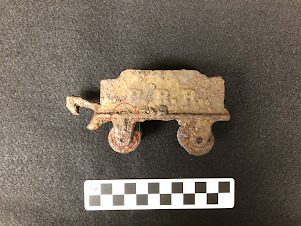The Pennsylvania Railroad at Yeaton-Walsh
At the Archaeology Open House last week, visitors' favorite artifact from the Yeaton-Walsh House was a piece of a model train. It is cast iron coal cart, and embossed with the letters P.R.R, referring to the Pennsylvania Railroad which began operating in 1846. I originally approached the artifact believing it was a toy and belonged to a Welch child. However, this interpretation fell through when I found that this coal cart was produced by Hubley Manufacturing. Based in Lancaster, Pennsylvania, Hubley began making cast iron train parts in 1894.
 |
| Cart from Yeaton-Walsh with wheel bracket circled to demonstrate shape. / |
Hubley manufactured floor trains, so they did not follow tracks. Their wheels were disk-like, as seen in this artifact image. For the brackets outside the wheel holding the axles in place, reproductions have a triangular shape but original Hubleys are oblong. Below is a 3d model of the artifact created through photogrammetry. It combines 84 images from different angles around the car, which was then rendered using Agisoft Metashape.
 |
| No. 994. in the 1909 "Lancaster Brand Iron and Steel Toys" catalog. Source: WorthPoint. |
The connectors linking train cars together and the screw head and placement also match. For decoration, there is a border of embossed dots around the P.R.R. In the 1909 catalog, the same coal cart is in 24 sets. Features and lengths vary, such as automatic couplers, electric engines, animal and freight cars.
This item may represent the Welches joining in the celebration of the railroad in Portsmouth. During the 1840s, over a dozen railroads connecting New Hampshire, Massachusetts, and Maine passed through the city. One of the most significant railroads during this period was the Great Falls & Conway Railroad. Opening in 1844, the company acquired lines in South Berwick, Portsmouth, Wakefield, Ossipee, and Rochester. In 1865, it became the Portsmouth, Great Falls & Conway Railroad, shuttling travelers to and from the White Mountains.
 |
| The North Conway Railroad Station, an extant landmark from the PGF&C Railroad. |
https://www.nh.gov/nhdhr/publications/documents/nh_railroad_context.pdf
https://atca-club.org/atca-toy-catalogs/hubley-manufacturing-company-the-lancaster-iron-toys-1906/
https://atca-club.org/atca-toy-catalogs/hubley-manufacturing-company-catalog-of-iron-and-steel-toys-1909/
https://atca-club.org/atca-toy-catalogs/hubley-manufacturing-company-catalogue-2-hubley-cast-iron-toys-that-sell-1929/
https://www.lancasterhistory.org/finding-aids/hubley-manufacturing-company-catalogs-and-newsletters-1922-1965/

Comments
Post a Comment